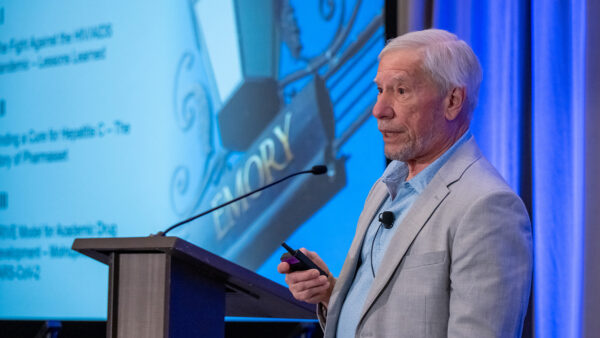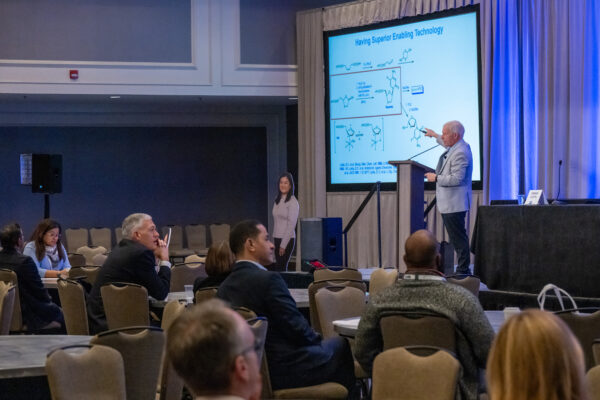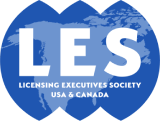
Viewpoints: Making New Drugs The Hard Way
LES Annual Meeting 2024 Keynote: Dr. Dennis Liotta, Emory University and The Liotta Research Group
When Dr. Dennis Liotta, a renowned scientist and tech transfer professional, stepped on the stage at the LES Annual Meeting, the audience eagerly looked forward to his remarks, and he did not disappoint. In his impressive career, he and his team have developed over 100 patented drugs. Liotta gave us an insider look at the development process for three groundbreaking treatments for HIV/AIDS, Hepatitis C and COVID-19.

Dr. Dennis Liotta explains the fascinating science behind his groundbreaking drug discoveries at the LES Annual Meeting in New Orleans.
Challenges in Academic Drug Development
Liotta outlined the unique challenges academic researchers face in drug development, including limited funding and a cautious approach to risk. He advocated for more proactive policies around intellectual property and enterprise building to bridge what he called the “valley of death” in drug development. With the looming threat of new pandemics, he emphasized the critical need for broad-spectrum antiviral drugs.
He explained the importance of understanding valuations during the drug development process, noting that valuations tend to increase with each successful experiment. The sweet spot for licensing is typically around phase two when safety and efficacy have been demonstrated in a small patient population. In an industry with fierce competition, he stressed the value of a well-rounded team with expertise in bioinformatics, formulation, and intellectual property to help offset the inherent disadvantages of academic settings.
Three Stories of Successful Drugs
Part 1: The Fight Against HIV/AIDS – Lessons Learned
Liotta shared the story and the chemistry behind Emtricitabine, an essential component in the widely used HIV treatment Atripla. He said, “The outcome was Emtricitabine, which is maybe the most widely used antiretroviral agent. We discovered it in 1990, and it’s still first-line therapy today. It’s first-line therapy because it combines well with many other antiretroviral agents, and we monetized our royalty rights almost 20 years ago, which are now $525 million.” Significantly, it improved patients’ quality of life, helping them move from taking 15-20 pills a day to taking one. In another component of Atripla, he explained, “Lamivudine became the first compound approved to treat Hepatitis B, bringing in about $150 million in royalties and milestones. But the true impact was incredible – over 90% of HIV patients have taken one of those two drugs at some point.”
Part 2: Finding a Cure for Hepatitis C – The Story of Pharmasset
In his second story, Liotta described wanting to do something more, which is how Pharmasset was born. It’s an acronym for pharmaceutical assets. He said, “One of the big unmet needs at the time was Hepatitis C, fully identified in 1989.” Liotta came up with the idea of substituting the fluorine for the two prime hydroxyls. He then described the complex chemical rationale for the development of the process.
This eventually turned into the blockbuster drug Sofosbuvir. He continues, “Sofosbuvir was an orally available drug, and it cured over 80% of patients who took it in just a 12-week regimen, taking one pill once a day, and it was a very fast rollout. Gilead Sciences charged $1,000 a pill. So you can do the math, take one pill every day for 12 weeks. That’s $84,000 for the regimen. And so I thought, gee, that’s a lot, but Gilead acquired the company for $11.2 billion, and I used to say $11 billion, but then one of my colleagues reminded me that point $2 billion is $200 million, and it’s a round off that I really shouldn’t be doing. The amazing thing is that Gilead made that $11.2 billion back in sales in 11 months.”
Part 3: The DRIVE Drug Innovation Ventures Initiative
In his final story, Liotta describes the formation of the DRIVE Drug Innovation Ventures initiative, a wholly-owned subsidiary of Emory University. The venture was designed to bypass traditional university policies and focus solely on drug development.
He highlighted the challenges of academic drug development, including the need for experienced leadership and development personnel. To address these challenges, DRIVE was created, bringing in commercial sector experts and focusing on antiviral drugs.
Liotta pointed to one of DRIVE’s significant achievements: identifying favipiravir, a compound active against single-stranded RNA viruses, including SARS-CoV-2. He explained, “Merck developed the compound, which is now called Molnupiravir, and it’s one of two oral agents that received emergency use authorization by the FDA. So far, we’ve brought in over $400 million in revenues to the university from this. The money gets people’s attention, but if you notice, I’ve tried to focus more on the impact, rather than the money.”
Conclusion
Dr. Liotta’s work highlights the transformative potential of academic drug development. It shows how intellectual curiosity and strategic industry partnerships can drive major public health breakthroughs. His legacy underscores the profound impact of dedicated research and collaboration in creating life-saving innovations.
# # #
About Licensing Executives Society (USA & Canada), Inc. (LES):
Established in 1965, LES (USA & Canada) is one of the longest running professional societies supporting the development of members engaged in the creation, commercial development, and orderly transfer of intellectual property. LES members include business executives, lawyers, accountants, consultants, and scientists and engineers; who represent innovation-oriented enterprises of all sizes, professional services firms, universities, and government labs. LES is the largest of 43 global member societies of the Licensing Executives Society International, Inc. (LESI). For more information about LES, visit www.lesusacanada.org.
Media Contact:
communications@les.org

Get Social